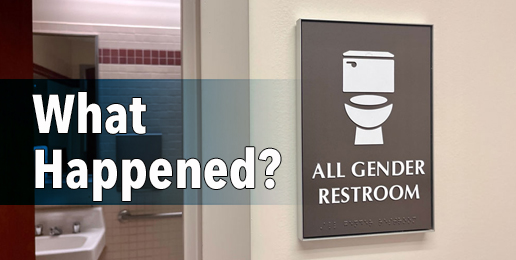
Two weeks ago, Governor Pritzker signed HB 1286, (Public Act 103-0518), allowing any multiple-occupancy restroom to be identified as an all-gender multiple-occupancy restroom at the discretion of the building owner or leaseholder.
Anyone of any “gender” could use it.
Why was this law introduced, why did it pass?
A few years ago, could anyone imagine such a law would ever have been signed? Who would even have thought this was a good idea? How did we arrive at the point where our elected representatives, supposedly speaking for us, believe this is ok? Is it ok?
I can’t see how this is in any way acceptable. The movement toward accepting multiple-occupancy all-gender restrooms is largely an outgrowth of the transgender movement.
Unless restrooms are designated as all-gender, trans-identifying people face what they consider to be discrimination in using the restroom that conforms to their identity. Hence this is part of their more significant movement for inclusion, particularly in sports.
This became thrust on us seemingly so quickly because of a decades-long movement to create social acceptance for what has become known as the sex-positive movement, including the move to normalize LGBT lifestyles and practices.
Essentially, it started with Alfred Kinsey, who was notoriously bi-sexual, and the release of his two seminal works, Sexual Behavior in the Human Male (1948) and Sexual Behavior in the Human Female (1953).
The publication of these works accelerated the sexualization of our culture that had begun in the early 20th Century. The acceleration sped up during the “Sexual Revolution” of the late ’60s and early ’70s, which propelled and was exacerbated by the removal of homosexuality from the Diagnostic and Statistical Manual in 1973. This added to the “anything-goes” atmosphere surrounding sexuality that grew in those years.
Still, while homosexuality was no longer considered a mental illness,
it remained unacceptable to most Americans.
Not so today.
Most people see it as a normal variation of human sexuality. Even some churches bought into this view early on, as recounted in the book Forgetting How to Blush: United Methodism’s Compromise with the Sexual Revolution by Karen Booth. The United Methodist Church even funded the sellout by backing two of its ministers, Ted McIlvenna and Laird Sutton, to work with the Glide Foundation and later the National Sex Forum (NSF).
During their tenure with the NSF, McIlvenna and Sutton developed a movie that provided the culminating experience of a seven-day seminar, known as the Sexual Attitude Readjustment (SAR) program, intended to equip professionals —psychologists, doctors, teachers, counselors, pastors, and other helping professionals—with a greater understanding of human sexuality and to help them become desensitized to the variety of sexual experiences.
A description of the SAR program, especially the film, is too vulgar for this publication. It is a collection of obscene triple X porn films, shown simultaneously on multiple screens, along with music, pulsating lights, and a host of sexual encounters depicting same-sex, opposite-sex, individual activities, and group performances.
The entire program is one of the pathways through which evil
has infiltrated and gained a beachhead inside many of our churches.
The SAR program was incorporated into the University of Minnesota’s College of Medicine educational recommendations. With funding from the Playboy Foundation, the University sent delegations to San Francisco to experience the SAR training. From the University, interest in the program spread to the headquarters of two Lutheran denominations in Minneapolis and from there, throughout the country and around the world. All this was happening in the late 60s and early 70s.
The SAR program is still being used today. To be AASECT certified (American Association of Sexuality Educators Counselors and Therapists) you must go through that program.
The sexualization of our culture went hand in glove with the efforts to promote the normality of homosexuality. After all, Kinsey and his minions had falsely claimed that human sexuality existed on a continuum, from exclusively heterosexual to exclusively homosexual and everything in between.
Kinsey also made the false claim that 10% of the population globally was exclusively homosexual. The effort to promote this false doctrine continued for decades but caught on mainly among the progressive elites. The average American still was not buying into this progressive view of sexuality.
Not until the ‘90s, anyway.
In 1987 Marshall Kirk and Hunter Madsen published The Overhauling of Straight America in Glide Magazine. Reportedly, they chose that magazine because its circulation primarily was among various religious groups.
They wanted to gain a broad audience for their ideas. Kirk and Madsen, members of the gay community of Cambridge, met while attending Harvard University, where Kirk studied Neuropsychology and Madsen majored in Government. Both were interested in persuasion and later became involved in the advertising profession, mass manipulation.
Their purpose was succinctly stated in the first paragraph of their article:
The first order of business is desensitization of the American public concerning gays and gay rights. To desensitize the public is to help it view homosexuality with indifference instead of with keen emotion. Ideally, we would have straights register differences in sexual preference the way they register different tastes for ice cream or sports games: she likes strawberry and I like vanilla; he follows baseball and I follow football. No big deal.
They proposed to accomplish this desensitization by following six principles they also laid out in the article.
1.) “Talk about Gays and Gayness as Loudly and as Often as Possible.”
This aims to numb the “raw sensitivities about homosexuality” by having “a lot of people talk a great deal about the subject in a neutral or supportive way.”
To achieve this, Kirk and Madsen said,“the imagery of sex should be downplayed and gay rights should be reduced to an abstract social question as much as possible. First let the camel get his nose inside the tent–only later his unsightly derriere!”
2.) “Portray Gays as Victims, not as Aggressive Challengers.”
The idea here is for gays to take on the victim role “so that straights will be inclined by reflex to assume the role of protector.”
Part of the plan was to distance themselves from the muscular “strong man” homosexual since they do not seem like victims, and from groups like the North American Man Boy Love Association (NAMBLA), at least in public, since nobody is going to buy pedophiles as victims (at least not in 1987). There also are two other elements to this principle:
“First, the mainstream should be told that gays are victims of fate, in the sense that most never had a choice to accept or reject their sexual preference. The message must read: ‘As far as gays can tell, they were born gay, just as you were born heterosexual or white or black or bright or athletic. Nobody ever tricked or seduced them; they never made a choice, and are not morally blameworthy. What they do isn’t willfully contrary – it’s only natural for them. This twist of fate could as easily have happened to you!’” . . .
“The second message would portray gays as victims of society. The straight majority does not recognize the suffering it brings to the lives of gays and must be shown: graphic pictures of brutalized gays; dramatizations of job and housing insecurity, loss of child custody, and public humiliation: and the dismal list goes on.”
Notice that Madsen and Kirk had no evidence to support what they were saying; this strategy was advanced as pure propaganda.
Indeed it was and is pure propaganda.
3.) “Give Protectors a Just Cause.”
According to Kirk and Madsen, the homosexual community should not immediately seek protection for their behaviors, instead they should point the protectors to a just cause “for consistent and fair treatment. . .” They say,
“[o]ur campaign should not demand direct support for homosexual practices, should instead take anti-discrimination as its theme. The right to free speech, freedom of beliefs, freedom of association, due process and equal protection of laws-these should be the concerns brought to mind by our campaign.”
4.) “Make Gays Look Good.”
This strategy involved publicizing support for the gay community from beloved Hollywood celebrities, gay or straight, and publicizing famous figures from history who were gay. In this way, the whole community begins to represent every man.
“In no time,” they wrote, “a skillful and clever media campaign could have the gay community looking like the veritable fairy godmother to Western Civilization.”
5.) “Make the Victimizers Look Bad.”
They proposed to vilify anyone who did not readily fall into line in support of the oppressed gay community. They said:
“At a later stage of the media campaign for gay rights-long after other gay ads have become commonplace-it will be time to get tough with remaining opponents. . . Our goal is here is twofold. First, we seek to replace the mainstream’s self-righteous pride about its homophobia with shame and guilt. Second, we intend to make the antigays look so nasty that average Americans will want to dissociate themselves from such types.”
6.) “Solicit Funds: The Buck Stops Here.”
The final point involved highlighting the need to raise money. A lot of money.
“Any massive campaign of this kind would require unprecedented expenditures for months or even years–an unprecedented fundraising drive.”
The authors laid out how easy it should be to raise funds, noting that there were ten to fifteen million homosexuals in the U.S. at the time, and if each donated only two dollars, it would raise more than enough to start a war chest to begin the propaganda campaign.
They planned to start the campaign in the gay press and later move to the mainline media after momentum began to build.
They wondered whether the gay community could be unified enough to contribute.
Kirk and Madsen spent the rest of the article storyboarding some ideas the propaganda campaign should include. Here’s an example:
“We have already indicated some of the images which might be damaging to the homophobic vendetta: ranting and hateful religious extremists neoNazis, and Ku Klux Klansmen made to look evil and ridiculous (hardly a difficult task).
“These images should be combined with those of their gay victims by a method propagandists call the ‘bracket technique.’ For example, for a few seconds an unctuous beady-eyed Southern preacher is seen pounding the pulpit in rage about “those sick, abominable creatures.” While his tirade continues over the soundtrack, the picture switches to pathetic photos of gays who look decent, harmless, and likable; and then we cut back to the poisonous face of the preacher, and so forth. The contrast speaks for itself. The effect is devastating.
” … it would portray gays as innocent and vulnerable, victimized and misunderstood, surprisingly numerous, yet not menacing.”
Does any of this look familiar?
Do you remember seeing any of this as it was being presented?
Two years after this article was published, Kirk and Madsen expanded their idea into a book: After the Ball: How America Will Conquer Its Fear and Hatred of Gays in the 90s.
Throughout the 90s, right up to today, we have seen their propaganda campaign implemented. It has been spectacularly successful. In 1996 only 27% of Americans supported gay marriage. Today that figure has risen to 70%.
Many churches perform them.
So, since 1948 the U.S. has undergone a huge shift, our culture moving from promoting purity as a value to mocking the idea that purity is a virtue. Since the early ’60s, this “sex-positive” movement began to include homosexuality as part of the normal range of human sexuality. And starting in the late 80s or early 90s, transgenderism became incorporated into that movement when the “T” was added to LGB.
Not only has this happened right under the nose of our churches, it has happened with the support and complicity of several major denominations.
The wolves didn’t infiltrate our churches.
We hired them, knowing their views.
Instead of pushing back against the cultural deterioration and moral decline, many churches are championing that decline, and very few oppose it.
How many pastors spoke out against the passage of SB 818, making the National Sex Ed Standards required for Illinois schools if the school boards approve?
How many spoke against allowing a transgender girl (a boy) in the girls’ locker room?
How many have publicly corrected the claim that “love is love” and that we cannot govern who someone “falls in love” with?
What pastors, or elders for that matter, have stood up before even their own congregations and clearly stated that a person is born male or female and that the very idea that someone can have a gender different from their biological sex is preposterous?
If all 350,000 religious congregations followed a biblical worldview in the United States, shouldn’t all the pastors of these congregations be speaking out on these issues?
Shouldn’t all the congregants be spreading the same message?
Where in the bible does it say that children should be educated on how to engage in sexual activity and encouraged to experiment with same and opposite-sex sexual activities?
Twenty-six percent of children in school right now identify as LGBT. Are the pastors educating the parents, the children, and the congregation on the truth about this issue?
Are they teaching them that nobody born a man can become a woman and nobody born a woman can become a man?
Do they challenge the false claim that LGBT children were born that way?
How many churches are calling out politicians, even those within their congregations, for voting in favor of laws promoting abortion, transgender surgery, and all-gender locker rooms and bathrooms?
We could chalk this all up to the fall and to sin, but that is letting everyone off too easy.
This gross decline in decency, in morality,
is the direct result of willful inaction by our churches.
It does no good at all to bring people into church if they are not discipled and taught a biblical worldview. According to a study by Barna, only 17% of practicing, regularly attending Christians have a biblical worldview. The percentage drops dramatically if all who profess Christianity are included.
In the last 50 years, we have witnessed the growth of all seven churches of Revelation, except for the church of Philadelphia. That church is becoming more difficult to find.
The silence and inaction, by our pastors, elders, and
entire congregations, completely explain what happened, and how we got here.
We may be baptizing people, but we are not making enough disciples, we are not transforming the culture.
We cannot allow the culture to continue to influence our families, churches, schools and policies. Christians are called to a much higher standard:
And do not be conformed to this world,
but be transformed by the renewing of your mind,
that you may prove what is that good and acceptable and perfect will of God.
~Romans 12:2






















